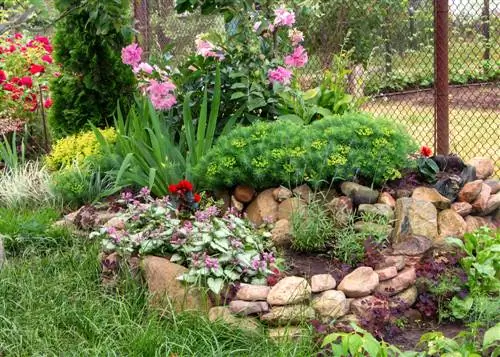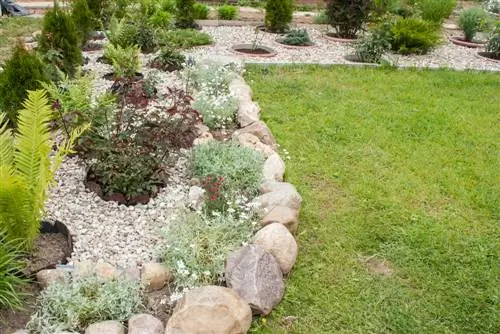- Author admin [email protected].
- Public 2023-12-16 16:46.
- Last modified 2025-01-23 11:21.
An attractive garden not only needs beautiful beds but also paths, both of which should be well planned. The paths serve to demarcate, but also to connect. Depending on the purpose, you can pave the paths or leave them unpaved.

How do I optimally create paths in a garden bed?
When creating bed paths, care should be taken to ensure a balanced width: Main paths should be approx. 1 m wide and paved, side paths only need approx. 30 cm wide and can remain unpaved. Various materials such as plaster, slabs or bark mulch can be used to create design accents.
How wide should a garden path be?
The optimal width of a garden path depends on its use. If you want to comfortably drive a wheelbarrow and park it at some point, then the path should be at least one meter wide. If there is little use, paths between the vegetable beds are about 30 centimeters wide. If you have very large feet, you may want to make the paths a little wider.
How do I pave a path?
It makes sense to pave the path if it is used frequently and/or if it is traveled with a wheelbarrow. You can also use the attachment as a design feature. There are various materials and options available to you, similar to a bed border.
If you want a very durable fastening, we recommend paving the path or laying paving slabs. Wooden paths that you design in the shape of a footbridge are less durable, but very decorative.
Curved paths loosen up the overall picture and make a small garden appear visually larger. Combine a path covered with bark mulch (€13.00 on Amazon) with a bed border made of field stones.
How do I create paths between vegetable beds?
Unpaved paths about 30 centimeters wide are sufficient between individual vegetable beds. To do this, simply tread the ground along a stretched cord. This means you can redesign the beds at any time if necessary. If you want to divide a large vegetable garden, then wide and narrow paths should complement each other sensibly.
The most important things in brief:
- pay attention to balance between beds and paths
- Main paths: approx. 1 m wide, enough for a wheelbarrow, secure
- Side paths: approx. 30 cm wide, no attachment required
- Cover unpaved paths that are often used with gravel or bark mulch
Tip
If you want to walk on an unpaved path even in rainy weather without your shoes getting dirty, then sprinkle it with gravel, wood chips or bark mulch.






